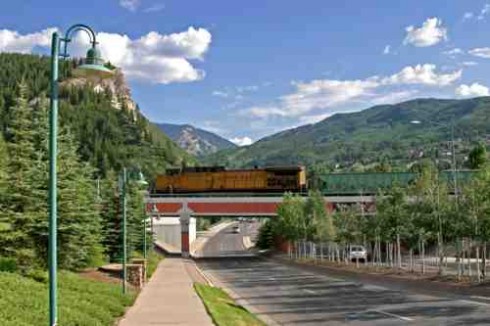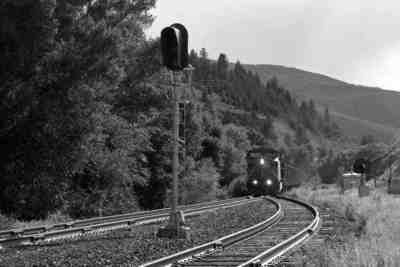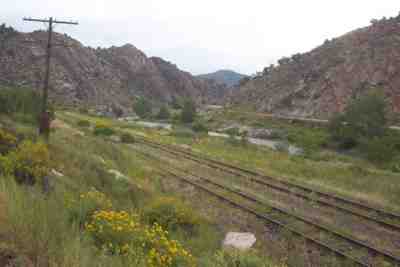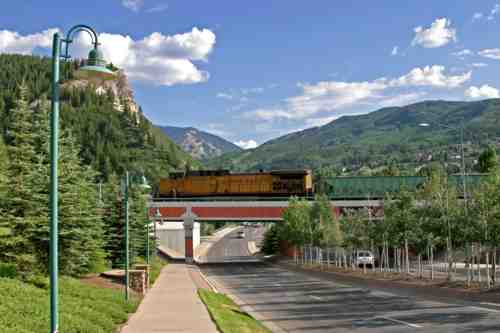Article by Kendal Stitzel
Transportation – October 2006 – Colorado Central Magazine
ONCE A TANGLED WEB of silver rails, Central Colorado has enjoyed something of a railroad renaissance at the turn of the 21st century. Despite the numerous ghosts of abandoned railroads, a streamlined passenger train now leaves every day from Cañon City to ply the tracks of the Royal Gorge, some of the passengers eating luxuriously in a full dining car. Above Leadville, a diesel pulls trainloads of tourists to timberline amid lovely mountain views. The San Luis and Rio Grande Railroad recently began passenger service over La Veta Pass then down to Antonito. In Antonito, the antique steamers of the Cumbres and Toltec continue to haul thousands back and forth into New Mexico. And plans remain afoot to revive a railroad line to Creede.
Amidst all this activity, the granddaddy of them all lies dormant: the rails of the Union Pacific (UP, nee Southern Pacific, nee Denver & Rio Grande Western). This former main line stretches from the Royal Gorge, along the length of the upper Arkansas, up and over Tennessee Pass, down to Minturn, and then westward through the ski sprawl towns of the Eagle River Valley. One to two dozen freight trains a day used to rumble through here. But, in 1997, cost-conscious UP stopped using the line in favor of its parallel Moffat Tunnel and Overland routes. So the right-of-way remains with rails intact — but now it’s mostly just a good place to walk your dog, play the bagpipes, or indulge in other meditative activities.

Diehard railfans, who used to thrill to the spectacle of loud grungy machines fighting to pull freight over steep mountain grades, pine away for the days of yore. They insist trains may roll again. UP may know but isn’t saying. What will happen to the rusting rails?
In the railroad equivalent of flyover country, the west has proven useful for storing freight cars not needed at the moment. The San Luis and Rio Grande, trying to be resourceful like any good business, found that its dormant branch from Monte Vista to South Fork made an ideal place to store “baretable” cars — long strings of flat cars used to haul truck trailers and steel containers. When business slows, you have to put the miles-long empty cars somewhere.
Spare freight cars lie at the center of a controversy that may bring the biggest change to the line since the through trains stopped eight years ago.
THE CONTROVERSY BEGAN this spring when the town of Avon announced plans for the “Riverfront Village,” a $500 million, 19-acre development slated to include a gondola, upscale hotel, shops, restaurants, condos, and timeshares. Quoted in the Vail Daily, Chuck Madison of the developer, East West Partners, offered this rationale for the project: “Many of the buildings that are in Avon today were built 20 to 30 years ago, and they’re in a state of decline. I think this will help allow for redevelopment of those buildings and remodeling.”
While a town more than 20 years old with declining buildings may not seem like a big problem to many westerners, Avon acts as the gateway to the posh Beaver Creek ski area and perhaps feels obliged to hide its graying roots.
One of the wrinkles, however, required getting permission from the Colorado Public Utilities Commission to build not one but two railroad crossings — one for cars, one for pedestrians — over the pair of UP tracks in Avon. (This was one of the infrequent passing sidings on the twisting route.) This must have seemed like a slam-dunk since the tracks had been almost entirely unused for about six years.
Not so fast, said UP. The railroad protested the crossings with an announcement that the railroad planned to store up to 500 box cars, coal cars, and miscellaneous other equipment at the yards in Minturn. Formerly stored in the Utah desert, the equipment was needed “closer to its point of utilization,” presumably the giant coal mines along the North Fork of the Gunnison River near Paonia.

On the surface, this looked like a logical move for the railroad. UP had stored spare cars from time to time on sidings on both the east and west sides of Tennessee Pass. Minturn had plenty of sidings. Why pay taxes on the property if you’re not going to get any use out of it? However, the timing was suspicious, given that UP hadn’t used Minturn before and seemed to have been startled out of its lethargy by the Avon plans.
During the summer, the battle took on humorous tones as the railroad sent a work train to fix a kink in the rails outside of Minturn, the first train east of Avon in seven years. During the work, UP made sure that the train parked overnight on a siding in Avon. Avon responded by passing a law forbidding trains from remaining stationary for more than 48 hours.
Meanwhile, citizens of the I-70 Sacrifice Zone responded with increasing horror to the prospect of trains returning to the Eagle Valley. Tom Sullivan, a town councilman in Minturn, expressed concern about the noise and visual impact of railroad cars returning to the yard. Ann Capela, Minturn Town Manager, feared teenagers would be lured to vandalize the cars or injure themselves.
Contrast this to the statement of a former Minturn mayor who a mere ten years ago said, “We’re a skuzzy little railroad and mining town and want to stay that way.”
Just as we regard people who build flammable houses in the fire-prone Stupid Zone, it may be hard to feel sympathy for people who build near a railroad track and then complain about the trains. But the issue went to court. UP downsized the number of cars it claims it wants to move into the Minturn yards, and Avon apparently prevailed in its grade-crossing plans.
UP has run nothing into Minturn after fixing the tracks, but has filed paperwork to downgrade the signal system west of Minturn to permit trains to slowly trundle into the valley from the west without requiring a new system.
EVEN THOUGH THE Avon and Minturn brouhaha concerned only the western side of the Tennessee Pass rails, had the towns inadvertently brought this unused railroad line back to the often-distracted attention of the corporate giant? Would the railroad consider reactivating the entire line? It seemed so when Internet rumors surfaced in the railfan community that UP had notified the Chaffee County Commissioners that train traffic would resume in 2007. This generated the usual arguments as skeptics scoffed and optimists hoped. Some observers suggested quite clever ways that UP could use Tennessee Pass to enhance the capacity of its rail network without major investment.
It seemed to make sense. Was this for real?

A certain magazine editor took it upon himself to investigate. Jerry Mallett, the chairman of the Chaffee County board of county commissioners, said that the county did meet with the UP’s real-estate department. The county sought a trail or easement along the tracks, roughly from the Salida sewer plant to Smeltertown. UP said nothing was for sale and that it wasn’t contemplating any changes for the trackage — neither abandonment nor restored operations. There was no mention of resuming service in 2007 or any other year.
UP apparently isn’t interested in selling, but there is one big change afoot — or rather at the head. CEO Dick Davidson is retiring. The man who oversaw the merger that gave UP ownership of the tracks through Central Colorado, he also oversaw the abandonment of many UP lines — lines that UP later desperately needed as it found it didn’t have enough capacity to run its trains. Insiders who knew Davidson say he was loathe to revisit such decisions. Maybe a new leader will look at UP’s resources — including Tennessee Pass — differently.
Various other rumors and red herrings have surfaced.
ALERT SPIES and even casual bystanders near Kobe (between Buena Vista and Leadville) couldn’t help but notice how someone had cut down the old trackside telegraph poles and salvaged the copper. Speculation identified this as the work of vandals, anxious to take advantage of the high copper prices. The truth showed this brazen crime was actually the work of a contractor, hired to remove the old wires and poles. The railroad had long ago switched to buried fiber optics.
Speculation also swirled last April when Phelps Dodge Corporation announced plans to reopen the Climax molybdenum mine above Leadville. Surely (the speculation ran) such an enormous operation would require renewed rail service. But, no, the mine used very little rail service before it closed. Any renewed production would likely be concentrated on site, trucked out, and processed elsewhere.

A definite plan recently emerged to tear up some Tennessee Pass rails — but only a few of them. In mid-August, the Environmental Protection Agency announced plans that it wanted to move huge quantities of toxic rocks from the zinc mine at Gilman in the Eagle River Canyon above Minturn. Rotting wooden mine cribbing threatens to give way, potentially dumping heavy metal bearing rocks into the Eagle River. The EPA wants to haul the rocks a short way to prevent the collapse and has proposed ripping up some of UP’s tracks to do so. (The apparently sensible idea of using the railroad to haul the rocks somewhere much farther away was rejected as too costly.)
This might not seem like the death sentence to the railroad that it seems. There are two tracks at the bottom of Eagle River Canyon, one on each side of the river. Even if UP doesn’t make the EPA rebuild the track, it would hardly sever the line against future use.
Thus, none of the portents and rumors have produced any trains. The line has also been known to host a mysterious track speeder, but he hasn’t been seen lately. Perhaps he was a ghost.
So, go ahead and walk the dog or take a hike on the tracks. Don’t expect real trains anytime soon. Just look out for ghosts.
Kendal Stitzel, in his guise as mild-mannered technical writer, lives in Fort Collins, commutes to Denver, is frequently unemployed, and has ridden freight trains through Central Colorado. (He asserts the latter to be a useful skill in today’s economy.) He is a member of the shadowy railfan splinter-cell organization, the Tennessee Pass Underground, which Zennishly conspires to watch nonexistent trains on empty railroads in Central Colorado.
References:
“Toxic rock may be moved”
http://www.vaildaily.com/artile/20060814/NEWS/60814004
http://www.vaildaily.com/artile/20060814/NEWS/60814004
For an extensive list of articles and commentary covering the spat between Union Pacific, Avon, and Minturn, go to the Vail Daily’s web site, type “railroad avon” into the search field on the home page, and click Go.


